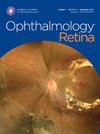Three-Year Outcomes of VEGF Inhibitors in Naive Branch Retinal Vein Occlusion
IF 4.4
Q1 OPHTHALMOLOGY
引用次数: 0
Abstract
Purpose
To evaluate the 3-year outcomes of VEGF inhibitors in the treatment of cystoid macular edema due to branch retinal vein occlusion (BRVO) in an international multicenter cohort of eyes.
Design
Multicenter, international, BRVO database study.
Subjects
Seven hundred forty-seven patients (760 eyes) undergoing intravitreal therapy for BRVO for 3 years in a multicenter international setting.
Methods
Demographics, visual acuity (VA) in logarithm of the minimum angle of resolution letters, central subfield thickness (CST), treatments, number of injections, and visits data was collected using a validated web-based tool.
Main Outcome Measures
Visual acuity gain at 3 years in logarithm of the minimum angle of resolution letters. Secondary outcome measures included anatomical results, treatment pattern, and percentage of completers. A subgroup analysis by study drug was conducted for clinical outcomes.
Results
Mean adjusted VA change was +11 letters (95% confidence interval 9–13), mean adjusted change in CST was −176 μm (−193, −159). Median number of injections/visits was 16 of 24 at 3 years of follow-up. Most eyes received VEGF inhibitors exclusively (89%, n = 677) and as a monotherapy in 71% (n = 538). Few eyes were switched to steroids (11%, n = 83). Suspensions in treatment >180 days occurred in 26% of study eyes. Aflibercept showed greater CST reductions (−147 vs. −128 vs. −114 μm; P < 0.001) and significantly lower switching rates (14% vs. 38% vs. 33%; P < 0.001) compared with ranibizumab and bevacizumab, respectively.
Conclusions
This international study of 3-year BRVO outcomes after starting treatment with VEGF inhibitors found adequate visual and anatomical results in routine clinical care. Visual outcomes were similar among the different initiating VEGF inhibitors, although eyes starting with aflibercept had better anatomical outcomes and a lower switching rate.
Financial Disclosure(s)
Proprietary or commercial disclosure may be found in the Footnotes and Disclosures at the end of this article.
血管内皮生长因子抑制剂治疗新生视网膜分支静脉闭塞的三年疗效:对抗视网膜失明!
目的 在国际多中心队列中评估血管内皮生长因子抑制剂治疗视网膜分支静脉闭塞(BRVO)引起的囊样黄斑水肿的 3 年疗效。方法使用经过验证的网络工具收集患者的人口统计学特征、以最小解像角对数表示的视力(VA)、中央子场厚度(CST)、治疗方法、注射次数和就诊数据。次要结果测量包括解剖结果、治疗模式和完成者百分比。结果 调整后的平均视力变化为+11个字母(95%置信区间为9-13),调整后的CST平均变化为-176 μm(-193,-159)。随访 3 年时,注射/就诊次数中位数为 24 次中的 16 次。大多数患者只接受了血管内皮生长因子抑制剂治疗(89%,n = 677),71%(n = 538)的患者接受了单药治疗。很少有眼睛改用类固醇治疗(11%,n = 83)。有26%的研究对象暂停治疗180天。与雷尼珠单抗和贝伐珠单抗相比,Aflibercept的CST降低幅度更大(-147 vs. -128 vs. -114 μm;P< 0.001),换药率显著降低(14% vs. 38% vs. 33%;P< 0.001)。不同的血管内皮生长因子抑制剂的视觉疗效相似,但开始使用aflibercept的眼睛具有更好的解剖学疗效和更低的转换率。
本文章由计算机程序翻译,如有差异,请以英文原文为准。
求助全文
约1分钟内获得全文
求助全文

 求助内容:
求助内容: 应助结果提醒方式:
应助结果提醒方式:


